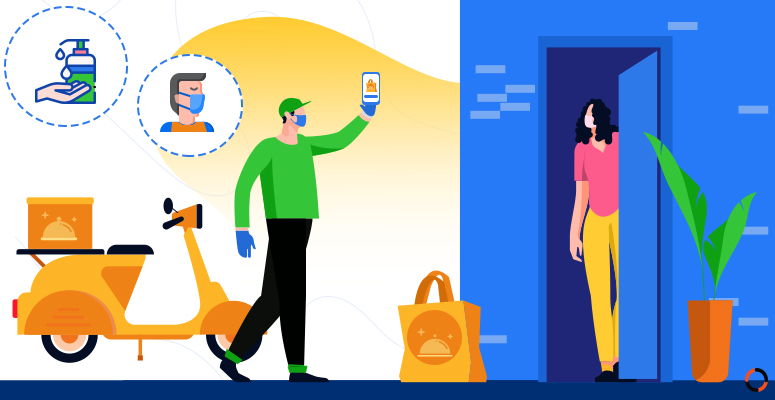Impact of coronavirus pandemic on restaurant food delivery business
- Restaurant Food Ordering System
June - 12 - 2020

Coronavirus continues to spread across the world at a brisk pace. All countries announced lockdown to break the chain of infection. People quarantined themselves by staying at their home. This pandemic changed their eating habits, and it created the fear of ordering food using online applications. Customers and delivery partners are giving priority to health and safety. So, Food aggregator applications have launched several initiatives such as no-contact delivery, mandatory use of face masks, hygiene practices, layoff announcements, and delivery of essential products. These initiatives helped towards maximizing safety in the delivery process.
No-Contact Delivery :
Online food ordering system launched no-contact delivery recently. Customers are using online payment methods for their orders, and they are requesting riders to leave the food at a safe place near the doorstep. Customers pay using debit/credit cards, net banking, digital wallets, or UPI. The rider leaves the food at the delivery location. He takes a clear photo of full doorstep and the food in front of it. He uploads the photo in his mobile application, and this photo will be sent to the customer. After uploading the photo, the rider knocks the door or ring the bell and walk away. The customer will collect the food from the doorstep. This initiative minimizes the contact between the rider and customer. Online food ordering platforms suspended the cash on delivery payment option for no-contact delivery.
Mandatory use of face masks :
When someone sneezes, coughs, talks, or exhales, they could release germs into the air. Mask helps to prevent the person from contracting infectious germs in the air. Food delivery companies offer masks to riders and restaurant staff. Online food ordering system introduced a feature in the delivery partner app to check the mask usage of rider. It mandates the rider to click a selfie with a mask and upload it for starting his duty. If the rider is not wearing a mask, then the system won't allow him to work.
Hygiene practices :
Food delivery companies take preventive measures to stop the transmission of virus by implementing hygiene practices. Restaurants increase the frequency of sanitizing in all areas such as kitchen, sinks, chairs, tables, billing counters, doorknobs, and door handles. Restaurant staffs use hand gloves. Hand wash stations are installed at the pick-up points of hotels to practice hand hygiene. Food delivery companies recommend their team members to keep on washing hands with soap and hot water. They instructed their employees to avoid touching the eyes, mouth, nose and following healthy habits. They check the temperatures of their entire staff every day. Food containers are packed in an extra bag so that it does not contact with anyone during the transit. Riders are using sanitizers after delivering each order.
Layoff announcements :
Orders on food ordering and delivery platforms have dropped a certain percentage amid the coronavirus pandemic. They are working with less number of restaurants, and minimal delivery partners. Big drop in online orders and no dine-in services impact the restaurant business severely. Hotels have been forced to shut due to the shortage of supplies and staff. COVID-19 hurt the food delivery business across verticals including cloud kitchens. Hotels and food delivery companies announced lay-off their employees due to the impact of the pandemic. They proposed a temporary reduction in salary for the entire organization.
Delivery of essential products :
Multi restaurant food delivery platforms began a new feature to deliver essential goods through their applications. Lockdown supported themselves to increase this new service across the nation. The food delivery application will be providing essential products by partnering with many brands. They launched a hyper-local delivery service that will pick-up the items from the neighborhood store and delivers it to the customer's doorstep. New services are classified under separate tabs within the application which will list the outlets and brands. The consumer purchases items based on their availability.
Categories
Recent Posts
- Solving Last-Mile Delivery Challenges in Restaurant Food Deliveries
- How to Start a Successful Multi Restaurant Delivery Service: A Step-by-Step Guide
- Tips and Ideas for Making Your Fast Food Restaurant More Environmentally Friendly
- A Brief Guide to Choosing the Right Takeaway Online Ordering System for Your Restaurant
- Essential Features of a Cafe POS System: A Must-Have Guide for Cafe Owners
- Mastering The Best Restaurant Advertising Campaigns Detailed Guide
- Complete Self-write Restaurant Business Plan Guide for Entrepreneurs
- 9 Best Restaurant Advertising Ideas to Elevate Your Business and Profits
- A Comprehensive Guide on How to Open a Food Truck Business and Succeed
- 5-Step Guide for Social Media Marketing for Restaurants
